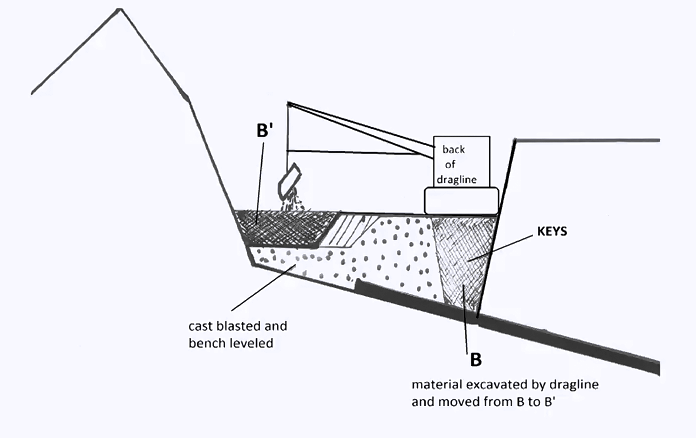All About Grading Contractors
Wiki Article
10 Simple Techniques For Concrete Contractors
Table of ContentsThe Best Guide To TrencherExcitement About Concrete Contractors6 Easy Facts About Excavating Contractors ShownGetting My Excavator To WorkThe Best Guide To Excavating Contractors


Scrapers or Pans dig deep into dirt in one area, haul as well as discard the dirt in another area (trencher). It is tough to match the performance of scrapers for cut/fill dirt operation if the haul range is less after that a mile. Scrapers are usually pulled by a rubber tire wheel tractor and are sometimes pushed through the cut area by a bulldozer.
There are often times that scrapes are not used for website grading and also a dump vehicle is used: the haul may be to long, the haul may cross roads where scrapers are not allowed, acid rock may be run into, devices availability, and so on. Dump vehicles are in usual usage and probably require little conversation.
Several vehicles have a top-hinged tailgate that can not dispose any kind of rock broader after that the tailgate width. "Rock body" beds, on the other hand, have no tailgates and also can discard any size rock, although their quantity capability is decreased. These internet links show devices specs for numerous common dump trucks. Compaction Devices raises the density of the soil and sometimes gives a smooth, rolled surface.
The Of Excavation Companies
From an easy examination pit to percussion boring to core drilling the owner has progressively extra costly alternatives that generate significantly far better data about the website underground. The Owner on a 100,000 SF building task may authorize twenty boring places with split spoon dirt examples taken up until rock is reached and also after that core samples of rock.Recognizing the type and also quality of rock (from the core samples) and also place of rock (from the dirts boring) is a genuine advantage in jobsite preparation. Alternatively, the Owner of a 100,000 SF building may determine to wage no geotechnical screening whatsoever. The choice regarding geotechnical testing is usually made by an Owner with no input from the Construction Manager.
The area on Soils and also Geology assists you recognize the terms in the geotechnical report. A knowledge of the approximate location of the rock helps the Building Manager to plan the series of steps adhering to rock excavation. If rock remains in one edge of a big building job, for instance, the earth excavation might start at the opposite end of the structure in order to start foundation work soonest.
Beginning the structure job early would be an excellent suggestion if the rock can be eliminated by tearing. If the rock is very difficult and calls for considerable blasting, it may be prudent to hold foundation job until the blasting is finished. The Building and construction Manager must work with these kinds of choices as well as utilize all the technological day readily available.
Not known Facts About Excavator
Unidentified excavation specifies that all rock or various other unexpected materials (leaving out unsafe materials) experienced in the sitework will certainly be the responsibility of the Contractor at no change in agreement cost. An unidentified excavation is less complex from a book-keeping standpoint as well as places the duty for geotechnical problems onto the Sitework Professional.Exactly How Water Influences Sitework? It's fantastic what a heavy rain can do to a building and construction job. Prior to the rainfall, the website might be dry, heavy devices effectively moving earth, the various other professions efficiently doing their job. Within hours the job can be a sloppy, mud-hole with worker effectiveness cut to about 10%.
In many areas of the globe, the Construction Manager have to bear in mind a straightforward reality: IT WILL CERTAINLY RAINFALL. Excellent planning can lessen the damages and disturbance of a heavy rain to a jobsite. Commonly the excavation and grading is left to the Sitework Professional (as well as important site their Foremen is accountable to supervise as well as direct the heavy devices and drivers).
The Building Manager must be constantly mindful of what rainfall will certainly do to the project website. It is not uncommon for the Sitework Supervisor to work their hefty devices for maximum efficiency and also hope it doesn't rain. Among the very best methods to get ready for rain is to incline all qualities to drain pipes and to smooth rolled the surface prior to a rainfall.
Rumored Buzz on Excavation Companies
The Building Supervisor need to be well-balanced sufficient to guarantee that heavy rainfall does not stop job on the project much longer than required. Daily discussions with Sitework Foremen might be called for to achieve this objective. At any time excavation is required listed below the existing water table on a job, the procedure of dewatering need to be considered.In a really natural dirt, the water travels so gradually through the clay or silt that dewatering is not typically essential for the relatively brief time of excavation. Dewatering might be required for a single footing excavation or for an entire job website. The most typical dewatering methods are trench drains, deep wells and well factors.

Ground water seepage can also be decreased by cutoff techniques such as sheet piling. High dewatering expenses have faded the revenue margins on much too numerous jobs.
This alternative should always be considered when examining the possibility of dewatering. Certainly the alternative is only feasible if gravity can run the water to reduced ground. Trench drains pipes can be cut with a backhoe and full of a crude, granular material (# 4 rock for instance), however care has to be exercised in picking the water outlet type and area.
The 9-Minute Rule for Excavator
A siphon, necessarily, makes use of air pressure to lug water from one altitude, up over a challenge, to a lower altitude. The pipes in a siphon system must be airtight and some resourcefulness is usually required to completely fill up the siphon pipe. The siphon pipe need to be full for the visit their website siphon to begin.A deep well includes a pump, pipe and an upright well casing. The pump consumption is at the bottom of the well casing (typically some crushed stone is positioned down there as a filter medium) (trencher). The water is pumped up the hose, out of the well casing, as well as to a suitable discharge place.
In a coarse sand, for instance, a big area can be pumped to near the pump consumption elevation. A less permeable dirt, on the various other hand, reduces the efficiency of a deep well. Since the pump is usually at the base of the deep well, there are no elevation constraints because of vacuum lift, as well as deep wells can lower the groundwater over 50 feet.
Under of the wellpoint there is a 2 foot long display as well as shutoff, water jets land clearing out of this shutoff and also creates an opening right into which the wellpoint pipe can be reduced. This hole is commonly made a larger diameter (for instance 10 inches) to permit for a rugged sand backfill to help filter the water (excavating contractors).
Report this wiki page